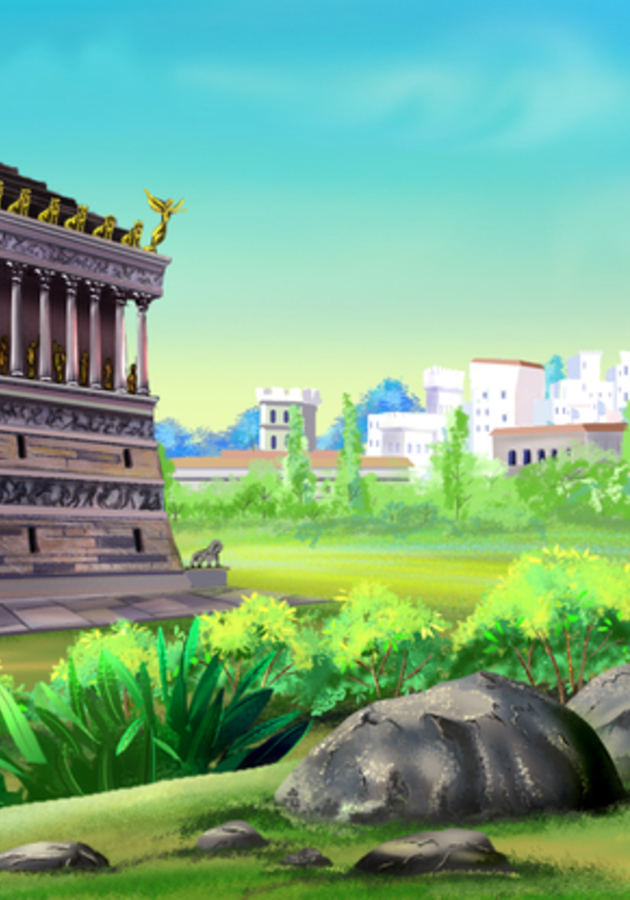Lying on the southwestern Aegean Region of Turkey, Bodrum is nowadays a rather quiet port town of fishermen, restaurateurs and sponge divers for most of the year. During the summer, however, it bustles with energy and vigor as tourists from all over the world come to visit its sights. The most remarkable among them is, surely, the Castle of St. Peter, erected by the Knights of St. John in the first quarter of the 15th century as a fortification against the Ottoman Turks. In 1494, preparing for an inevitable attack, the Knights set about strengthening their fortress. While quarrying for stone, they came upon the ruined columns, sculptures and friezes of an ancient monument. Before too long, they began smashing the statuary and burning the marble to make lime mortar. They worked fast and by 1520, almost everything had been disposed of from the structure, down to its very foundations.
Today, at the site of this 16th-century quarry, there is really nothing but a pile of ancient marble and rubble, scattered around a serene and sunny garden. But two millennia ago, there stood, in all its majesty and glory, a 150-foot tall tomb (45 m), one of the Seven Wonders of the World. Covering an area of more than 13,000 square feet (1,200 square meters), it eclipsed all other tombs in the world, both in size and grandeur. It was so astounding and remarkable that all the finer cemeteries of the Western world – especially the ones built in the 19th and 20th century – are full of sepulchers that take their name from the ruler this tomb was dedicated to. His name wasn’t Alexander, Croesus (Kree-sus), or Cyrus; it was Mausolus, a minor king of an ancient Anatolian kingdom called Caria.
Mausolus and Artemisia
In ancient times, Caria was a region of southwestern Anatolia, extending along the coast from mid-Ionia to Lycia on the south, and to Phrygia (FRIDGE-ee-ah) on the east. The area was colonized by Ionian and Doric Greeks in the Late Bronze Age, but the Carians never really spoke Greek, as Homer attests in the “Iliad,” where he qualifies their speech as “barbaric” and “incomprehensible.” Sometime during his reign, Croesus (kree-sus), the fabled King of Lydia, incorporated Caria into his short-lived Lydian empire. After Croesus’ defeat at the hands of Persian ruler Cyrus the Great, Caria became a satrapy (say-trah-pee) (province) of the Persian Empire. During the Persian invasion of Greece, the Carians were allies of Xerxes (ZERK-sees) I, but afterward, they became members of the Athenian-led Delian league. In 428 BC, they returned to Persian rule once again and remained so until Alexander the Great defeated the Persians at the Battle of Halicarnassus in 334 BC.
It was there, at Halicarnassus, that Mausolus (whose name, in Carian, probably meant “The Much Blessed One”) moved the capital of his country in 370 BC. Four years later, he took part in the Revolt of the Satraps, a famous but unsuccessful rebellion of several Persian governors against the authority of the Great King Artaxerxes (arta-zerk-sees) II Memnon. A capable and smart tactician, Mausolus used the chaos caused by the Revolt to conquer a great part of the neighboring Lycia and Ionia, and even several Greek islands. In the process, he managed to carve himself an almost independent dynastic role whilst propelling Caria into a short-lived Golden Age. A devoted lover of Hellenic culture, Mausolus was also a great supporter of art and artists and so, during his reign (from 377 to 353 BC), Halicarnassus became not only one of the most modern, but also one of the most beautiful cities along the entire Mediterranean coast.
Possibly for dynastic reasons, Mausolus married his sister Artemisia in the 370s. It was her, according to most ancient sources, that gave the orders for a grandiose tomb for her brother-husband, after his death in 353 BC. However, we know that she passed away just two years later, and the span seems just too short for such an ambitious project. Hence, archaeologists believe that some plans for the tomb must have existed even before Mausolus’ death. Either way, it was probably Artemisia who oversaw the laying of the foundation, and the first phases of construction. Renowned in history for her extraordinary grief, she is regularly shown in sculptures and paintings with a cup. If we are to believe ancient writers, Artemisia used one to mix her husband’s ashes with her daily drink, which she then slowly consumed. She believed, Renaissance writer Giovanni Boccaccio says, that there was a better resting place for her Mausolus than an urn, or even a grandiose tomb – namely, her own heart.
The architecture of the tomb
Once a fearsome commander and naval strategist, Artemisia spent the last two years of her life in mourning, slowly fading away. Boccaccio says she died happy, in the belief that she was going to her brother-husband. By all accounts, the only thing she did during her brief widowhood was make sure that Mausolus would have the most sumptuous sepulcher in the world. Whatever the original plans were, she certainly expanded upon them, using Mausolus’ standing as a major player in regional power-politics to gather the sources necessary to make his tomb a worthy symbol of her love. Not satisfied with having just one sculptor – Pythius, who was also the main architect – she ordered Scopas, Bryaxis, Timotheus, and Leochares (who, at the time, were reputed in Greece to be the greatest sculptors in the world) to come to her as well. Even though by the time Artemisia died, the artists hadn’t finished the tomb yet, they were supposedly so proud of their work that they completed it afterward, as a monument to their own skill.
Even if not believable, the story doesn’t seem unlikely, considering the sheer size and beauty of the tomb. Roman encyclopedist Pliny the Elder tells us that the structure rose to a total height of 148 feet (45 m), and that it was a three-tiered building. Almost square in plan, it rested on a large, three-stepped podium measuring 125 x 105 feet (38 x 32 m), beyond which there was a colonnade of 36 Ionic columns running around all four faces and separated from each other by 10 feet (3 m). Above the colonnade, a 24-stepped pyramid rose, topped by a gigantic four-horse chariot group. According to Pliny, the colonnade occupied close to one-third of the monument’s height, and the height of the pyramid, based on a surviving stair, can be calculated as 22 feet (7 m). Since the remains of the chariot group suggest that it stood an impressive 19.7 feet (6 m) high, this would then leave a whole 66 feet (about 20 m) for the podium.
These calculations suggest that the podium alone would have required around 870,000 cubic feet (25,000 cu. m) of stone to be sourced, cut, transported and put in place! Whence and how the materials came to Halicarnassus, we don’t really know. Only the greenish volcanic stone used for the foundations and the interior was available locally, whereas the blue limestone and white marble blocks, which were used to face the structure, had to be imported from further away. Analyses have shown that one of the two great friezes of the structure must have been sculpted in marble brought in from the nearby island of Kos, whereas the other was undoubtedly completed in Phrygian (FRIDGE-ee-an) marble, either bought or smuggled in from the Afyon Province. Considering the size of the columns and the height to which they had to be raised, it’s not difficult to determine that cutting-edge cranes were used during the construction. As technologically advanced as they might have been, they are beside the point. For it was the artistic beauty of the tomb which qualified it for a place among the Seven Wonders of the World.
The sumptuous statuary
Even though the tomb of Mausolus was, by far, the biggest of antiquity after the Egyptian Pyramids, it wasn’t so much its size that earned it a place on the wonder lists as the truly spectacular character of its sculptural endowment, both as to quantity and quality. Whether it was Artemisia or Mausolus himself who had the original idea of the edifice, they certainly wanted to make a political statement through it. Caria, especially after Mausolus’ conquests, was an international, multiethnic kingdom, uniting Greek and non-Greek people. By combining Greek, Lycian and Egyptian architectural features, Mausolus’ tomb was meant to symbolize his desire for brotherhood and unity. The tomb’s greatest triumph, however, wasn’t its esthetic eclecticism, but its marvelous feat of bringing together architecture and sculpture in a never-before-seen symbiotic relationship. Predictably, this relationship of balance and beauty between the two arts will be echoed in many subsequent buildings and edifices.
Unlike, say, an Egyptian pyramid, there was, indeed, an awful lot of sculpture and statuary adorning the tomb of Mausolus. Not only was it topped by a huge four-horse chariot, but there were also two beautiful friezes which ran continuously around all faces of the tomb. The first one, at the very bottom of the podium, depicted the mythological battle of the Lapiths and Centaurs, whereas the other, placed on the third and last stair of the pedestal, portrayed the battle between the Greeks and the Amazons. Between them, there were numerous freestanding figures and sculptures, as there were above them, in the colonnade, one next to each of the columns, so 36 in all. Even higher, at the foundation of the pyramid, dozens of lions, life-size or larger, prowled around on sumptuous, blue limestone bases, keeping the chariot group above them. Not one of these statues was made in the old, classical styles; all of them looked like real animals and real individuals, in the same way that the Hellenistic traditions would carry on.
Ancient writers claim that four of the five sculptors were each responsible for one side of the tomb, while the fifth one, probably Pythius, fashioned the chariot group. “In carving the statues and the friezes,” writes Boccaccio thousands of years later, “each of the artists wanted to surpass the others, and so they expressed the power of their genius with such tremendous subtlety that those who watched sometimes thought that the marble faces were alive.” 19th-century excavation of the site disclosed that another layer to the vivacity of the statues was added through the use of color. We now know that most of the statuary of the tomb – if not all – had been colored in its original state: bright red for flesh, purple for armor and drapery, red-brown for hair and beards and a blue background for the bas-reliefs. The lion figures around the age of the roof were, naturally enough, painted yellow-ochre.
Later history of the tomb
The tomb of Mausolus was characterized by a hitherto unprecedented degree of mathematical regularity. Not only was it built with its dimensions and proportions worked out precisely in the foot measure of the time, but – from what we can infer from ancient authors – the number and the positions of the statues was also predictably consistent with the entire design. That’s how the balance between the two arts – architecture and sculpture – was achieved. To both poise and offset the sheer size of the entire monument, most of the statues were either lifelike or slightly larger. We know this for a fact, since in 1857, shortly after identifying the original site of Mausolus’ tomb, British archaeologist Charles Thomas Newton and his team excavated two, largely intact, 10-foot (3 m) statues from the ground below. Even though hesitantly, these two have since been identified as none other than the royal couple, Mausolus and Artemisia. If so, they must have originally stood in the front center of the tomb’s colonnade.
We know neither why nor how they remained only partly damaged. We can only suppose that the demolishers of the tomb, the Knights of St. John, displayed some mercy toward them, for one reason or another. They weren’t as kindhearted to any other part of the tomb. In fact, if nothing else, Newton’s excavations clearly demonstrated the extent of the Knights’ vandalism. Before, it was supposed that a lot of it had already been destroyed by several successive earthquakes between the 12th and the 15th century, but a sledge-hammered sculpture of a mounted Persian rider, now located in the British Museum, shows how ruthless and determined the Knights must have been in their attempts to quickly produce lime for refortification of the Castle of St. Peter. Hence, it’s possible that Mausolus and Artemisia – if it is really them – were just deeper into the soil than the Knights had cared to delve, and that they never actually found them.
In 1522, they found something even more valuable: the tomb chamber itself. Within it, they came across a marble coffin and a plethora of riches. For reasons unknown, they decided to postpone further exploration until the following day. This turned out to have been a mistake on the Knights’ part, for when they returned, the coffin had been broken into by pirates and only some fragments of bejeweled cloth and a scatter of gold remained. Modern excavations have virtually confirmed the Knights’ story; however, based on what we know today, it’s unlikely the riches would have fared any better in their own hands. But let’s not end our overview of this magnificent tomb with such a sad sight. For even though almost none of it remains today, it has essentially served its original purpose. Artemisia, remember, built the tomb to ensure the immortality of her husband-brother – and that, undoubtedly, she did. Fearing the word “tomb” not good enough to describe this splendid structure, the Greeks named it “Mausoleion,” after the king buried in it. In many languages, all sepulchers today are called mausoleums, after this one, the worth iest of all.
Sources
Main
- Paul Jordan, Seven Wonders of the Ancient World (Routledge, 2002).
- Christopher Scarre, ed. The Seventy Wonders of the Ancient World (Thames & Hudson, 1999).
- Lynn E. Roller, “The Mausoleum at Halicarnassus,” An Encyclopedia of the History of Classical Archaeology [Nancy Thomson de Grummond, ed.] (Greenwood Press, 1996), pp. 736-7.
Ancient
- Pliny, Natural History xxxvi.4.30. [http://attalus.org/translate/pliny_hn36a.html#30]
- Vitruvius, De architectura, vii. [https://penelope.uchicago.edu/Thayer/E/Roman/Texts/Vitruvius/7*.html#Mausoleum]
Other
- Giovanni Boccaccio, “Artemisia, Queen of Caria,” Concerning Famous Women [translated by Guido A. Guarino] (Rutgers University Press, 1963), pp. 123-127.
- Peter D’Epiro & Mary Desmond Pinkowish, “What Are the Seven Wonders of the World?” What Are the Seven Wonders of the World?: And 100 Other Great Cultural Lists (Anchor, 1998), pp. 179-187.





























